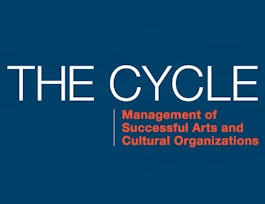Arts and culture leaders have a tough but rewarding task: creating and leading sustainable organizations that deliver real social value. There is a lot of competition out there. Being an effective leader means constantly adapting, cleverly using the best tools to reach as many people as possible. This course is designed to help leaders at any level do just that.


Arts and Culture Strategy
Taught in English
Some content may not be translated
24,099 already enrolled
(203 reviews)
Details to know

Add to your LinkedIn profile
2 quizzes
See how employees at top companies are mastering in-demand skills


Earn a career certificate
Add this credential to your LinkedIn profile, resume, or CV
Share it on social media and in your performance review

There are 5 modules in this course
We welcome you to this five-unit course with a brief history of the world relative to arts and culture and where we are now. What is the substance of value (objective/subjective) – to whom, for what? What are the essential and timeless issues facing us? How do we connect and interlock mission and value to be supportive, contingent and flexible?
What's included
9 videos1 reading1 quiz
How do we deliver on value? This week explores form and function of organizations. By the end of the unit, you will clearly understand organization structures – historic and behavioral biases that keep us from changing current structures, frameworks and logic that build better structures. And you will better understand risk - how best to identify and manage it.
What's included
8 videos2 readings1 peer review
To answer this question we need to understand and evaluate the critical features of our external environment. This will give us context to identify the unique values organizations can bring to communities that build support and allow for stronger collaborations. We will be better able to balance artistic and economic choices, and create differentiation and positioning that attract, serve and keep participants and customers.
What's included
6 videos1 reading1 peer review
A tension exists between artistic/mission and economics. As much as we’d like to try, we can’t be everything to everyone. We must find alignment and balance. How do you recognize and systematically respond to changes in your community? In this unit we’ll explore advancing your mission through a sharp focus on customers and markets; how best to understand the needs and interests of stakeholders; how to identify the best target-customer segments for your organization/project; and how to attract and retain those customers.
What's included
6 videos1 reading1 peer review
Who determines value and how do you influence that determination? In this unit, we look at meaningful measures and meaningful communication. How do you test value? How do you make timely decisions? How do you communicate to the vast variety of stakeholders who support your organization or will support your organization?
What's included
7 videos1 reading1 quiz
Instructors


Recommended if you're interested in Governance and Society

University of Maryland, College Park

Coursera Project Network

University of Illinois at Urbana-Champaign
Why people choose Coursera for their career




Learner reviews
Showing 3 of 203
203 reviews
- 5 stars
76.58%
- 4 stars
18.04%
- 3 stars
3.41%
- 2 stars
0%
- 1 star
1.95%

Open new doors with Coursera Plus
Unlimited access to 7,000+ world-class courses, hands-on projects, and job-ready certificate programs - all included in your subscription
Advance your career with an online degree
Earn a degree from world-class universities - 100% online
Join over 3,400 global companies that choose Coursera for Business
Upskill your employees to excel in the digital economy
Frequently asked questions
Access to lectures and assignments depends on your type of enrollment. If you take a course in audit mode, you will be able to see most course materials for free. To access graded assignments and to earn a Certificate, you will need to purchase the Certificate experience, during or after your audit. If you don't see the audit option:
The course may not offer an audit option. You can try a Free Trial instead, or apply for Financial Aid.
The course may offer 'Full Course, No Certificate' instead. This option lets you see all course materials, submit required assessments, and get a final grade. This also means that you will not be able to purchase a Certificate experience.
When you purchase a Certificate you get access to all course materials, including graded assignments. Upon completing the course, your electronic Certificate will be added to your Accomplishments page - from there, you can print your Certificate or add it to your LinkedIn profile. If you only want to read and view the course content, you can audit the course for free.
You will be eligible for a full refund until two weeks after your payment date, or (for courses that have just launched) until two weeks after the first session of the course begins, whichever is later. You cannot receive a refund once you’ve earned a Course Certificate, even if you complete the course within the two-week refund period. See our full refund policy.



